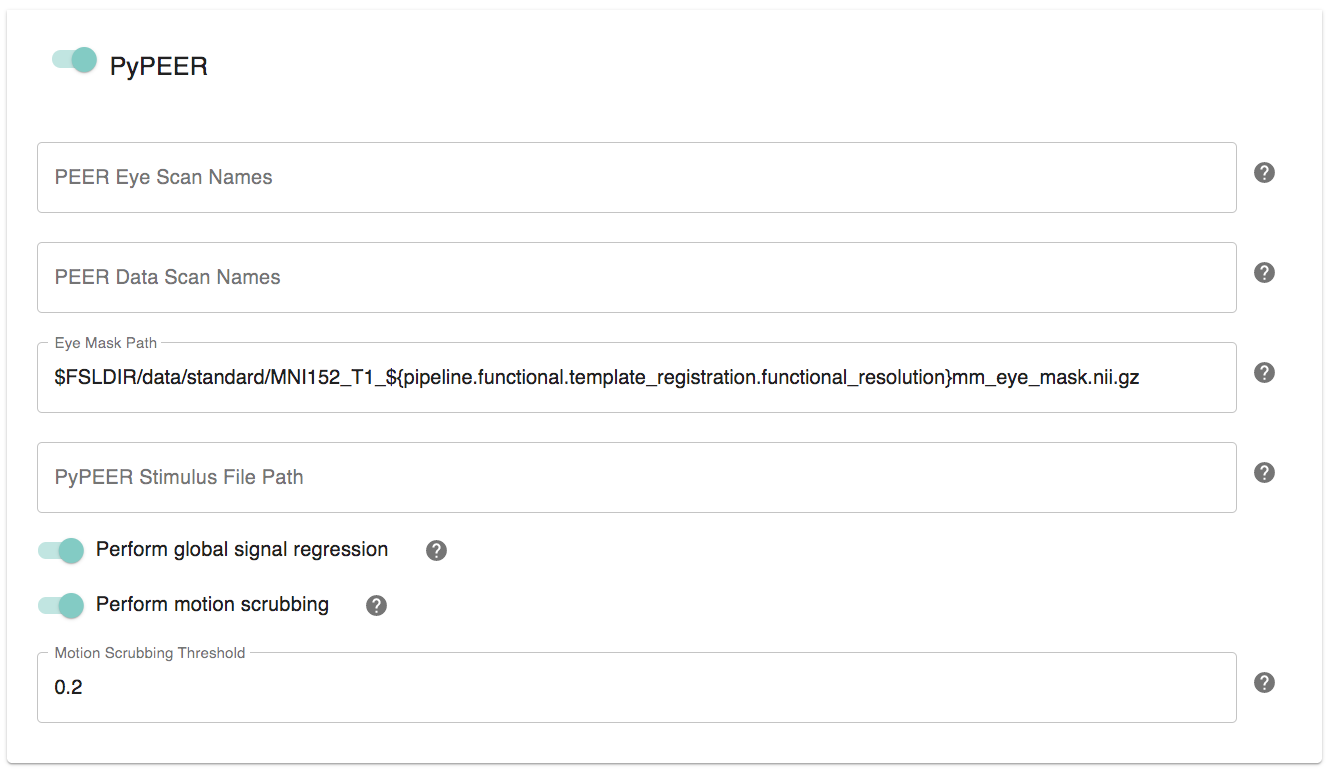PyPEER Integration#
PEER is a previously developed support vector regression-based method for retrospectively estimating eye gaze from the fMRI signal in the eye’s orbit. PyPEER is the Python package created by Jake Son [https://github.com/ChildMindInstitute/PyPEER] which implements the PEER method in Python.
C-PAC can prepare your pipeline results directly for Predictive Eye Estimation, given the appropriate input files. The PyPEER package comes pre-installed in the C-PAC Docker and Singularity containers, so no setup is necessary.
Configuring CPAC to Run PyPEER#

PEER Eye Scan Names: Scan/series names of the PEER calibration scans to be used for training the model.
PEER Data Scan Names: Scan/series names of the naturalistic viewing data to be used for estimation.
Eye Mask Path: Path of the file of a template-space eye mask. The default selection is bundled with the C-PAC container from the FSL installation.
PyPEER Stimulus File Path: This is a file describing the stimulus locations from the calibration sequence.
Perform Global Signal Regression: PyPEER employs a minimal preprocessing strategy. If global signal regression is desired, this can be selected here. C-PAC will not employ its standard nuisance regression selections on scans selected for PEER calibration and estimation.
Perform Motion Scrubbing: PyPEER employs a minimal preprocessing strategy. If motion scrubbing is desired, this can be selected here. C-PAC will not employ its standard nuisance regression selections on scans selected for PEER calibration and estimation.
Motion Scrubbing Threshold: The threshold for motion (in mm) to use for motion scrubbing, if it is selected. PyPEER employs the Power (2012) measurement for framewise displacement.
Configuration Without the GUI#
The following nested key/value pairs will be set to these defaults if not defined in your pipeline configuration YAML.
References#
Jake Son, Lei Ai, Ryan Lim, Ting Xu, Stanley Colcombe, Alexandre Rosa Franco, Jessica Cloud, Stephen LaConte, Jonathan Lisinski, Arno Klein, R. Cameron Craddock, Michael Milham. Evaluating fMRI-Based Estimation of Eye Gaze during Naturalistic Viewing. https://doi.org/10.1101/347765
Fox, M.D., Zhang, D., Snyder, A.Z., Raichle, M.E., 2009. The global signal and observed anticorrelated resting state brain networks. J Neurophysiol 101, 3270-3283.
Power, J.D., Barnes, K.A., Snyder, A.Z., Schlaggar, B.L., Petersen, S.E., 2011. Spurious but systematic correlations in functional connectivity MRI networks arise from subject motion. Neuroimage 59, 2142-2154.
Power, J.D., Barnes, K.A., Snyder, A.Z., Schlaggar, B.L., Petersen, S.E., 2012. Steps toward optimizing motion artifact removal in functional connectivity MRI; a reply to Carp. Neuroimage.